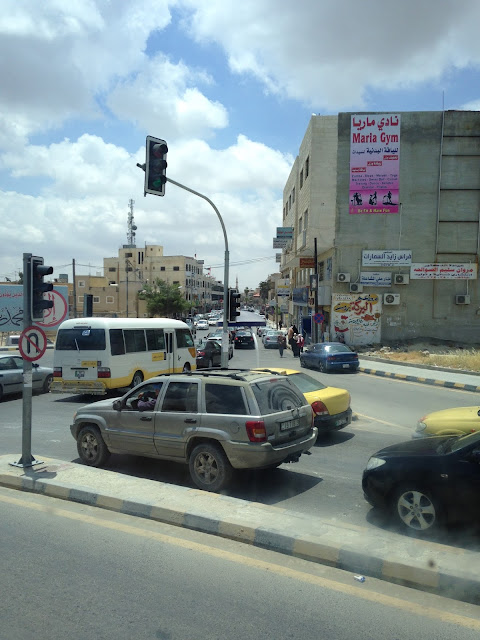Our bus dropped us off near the top of Mount Nebo, at an incredibly scenic lookout. The area contains religious significance, meriting visits from figures like Pope John Paul II. After all, this region is around the River Jordan of Biblical fame, in which John the Baptist performed his baptisms (If I'm not mistaken), from which the Kingdom of Jordan is named, and which defines the border between the West Bank and Jordan (after all, it used to be called Transjordan, across the River Jordan). From the site, we could see Amman in the distant background towards the northeast, the river valley that's home to much of Jordan's agriculture, Jericho, the Dead Sea, and distant mountains in Israel. Also Jerusalem was only about 45 km away. What a view.
Afterwards, we lunched in a resort next to the Dead Sea. The lunch was a buffet that featured probably the only fish I've seen since arriving in this country. We then went to the beach of the Dead Sea.
It's common knowledge that the Dead Sea is so salty that one can float in it. Some of us thought it'd be a neat gimmick that'd be old in ten minutes. But it's actually a surprisingly weird sensation when you're actually sitting there, floating without any effort. It's difficult to swim because the water will force your legs and arms to rise to the top of the water. Because of all of the salt, the water also burns your eyes and nose if any water gets in them. If any gets in your mouth, it's like dumping a pinch of salt right on your tongue. It's no bueno. The site also had Dead Sea mud for slathering on your body. Why? Who knows. We spent about two hours fascinated by very salty water.
I spoke to our guide about the lives of Christians in Jordan. The Christians and Muslims in Jordan apparently live very harmoniously. Both groups are Arabs, and Jordanian, with a very long shared history as Arabs and as the inhabitants of the area. As our guide explained it, the people in this region were here a very long time. At first they were Jewish. Later, some of them converted to Christianity. Later, some converted to Islam. However, it's still the same people in the same place, who have a sense of belonging to the same community.
He continued to explain that the leadership in local churches receive their authority from the Patriarch in Jerusalem. The government plays no role in the affairs or leadership of churches in Jordan. In masjids, however, imams have to be approved by the Ministry of Islamic Affairs. This is to prevent imams with unsubstantiated or extreme views from negatively influencing other citizens, and to ensure that the imam is qualified to fulfill the role. Although the government and the King supports Islam (the Hashemite dynasty claims to be descended from the Prophet Muhammad), only inheritance law and another type of law (I forgot) are based on the Qur'an. The rest of the laws are from non-religious sources.
The Ministry also determines the religious curriculum for Jordanian students, who learn about Judaism, Christianity, and Islam in school. This is done, as it was explained to me, in a manner to foster understanding across faiths, and is one of the reasons why Jordan is relatively free of extremist and fundamentalist thought compared to many of its neighbors. The country produces very few fighters for ISIS, for example. And while nearby Syria, Lebanon, and Iraq have succumbed to sectarian violence, now or in the past, Jordan has been free of such incidents. So while Jordan is not a secular country, it seems to promote a moderated outlook on religion.
Culture/Language notes:
- The further we get from Amman, the less English there is on signs and streets. And that's simply to be expected, most of the target audience for English signs and advertising is in Amman, where literally half the country and probably almost all of it's foreign nationals live.
- Although the modern state Jordan is a very new one, the name "Jordan" has connotations and history that stretch back to Old Testament times. When speaking historically, usually Jordan refers to the Biblical River Jordan and the surrounding area in modern day Israel and Jordan.
A mural in Madaba
More murals in Madaba
A plaque that commemorates the visit of Pope John Paul II
One view from Mt. Nebo
A panoramic view. Amman can barely be seen in the distance
Not really sure how this picture happened
It's hard to read, but this map from the museum puts the region in context. Mount Nebo is to the center-right. Madaba can be seen to the East, Amman to the North, and Jericho to the West. The river is the River Jordan that feeds into the Dead Sea. Further West of Jericho is Jerusalem. And Mount Nebo overlooks all of it.
More maps and context
Another panorama from a different view, although this one has a little too much sand brick and not enough Jordan river valley. The turquoise sliver on the far left is the Dead Sea. The green is around the city of Jericho and the River Jordan. The mountains that are the backdrop to the whole scene are in the West Bank.
Less pano but more valley












No comments:
Post a Comment